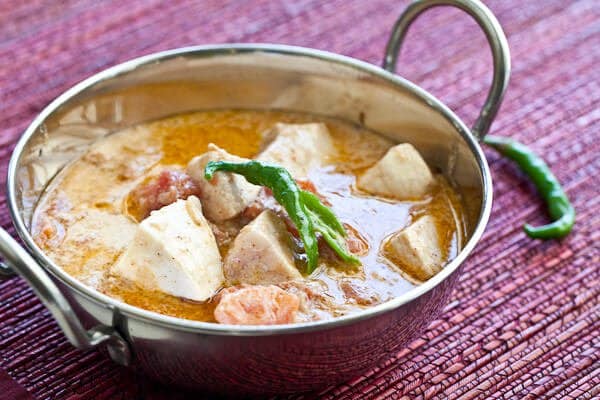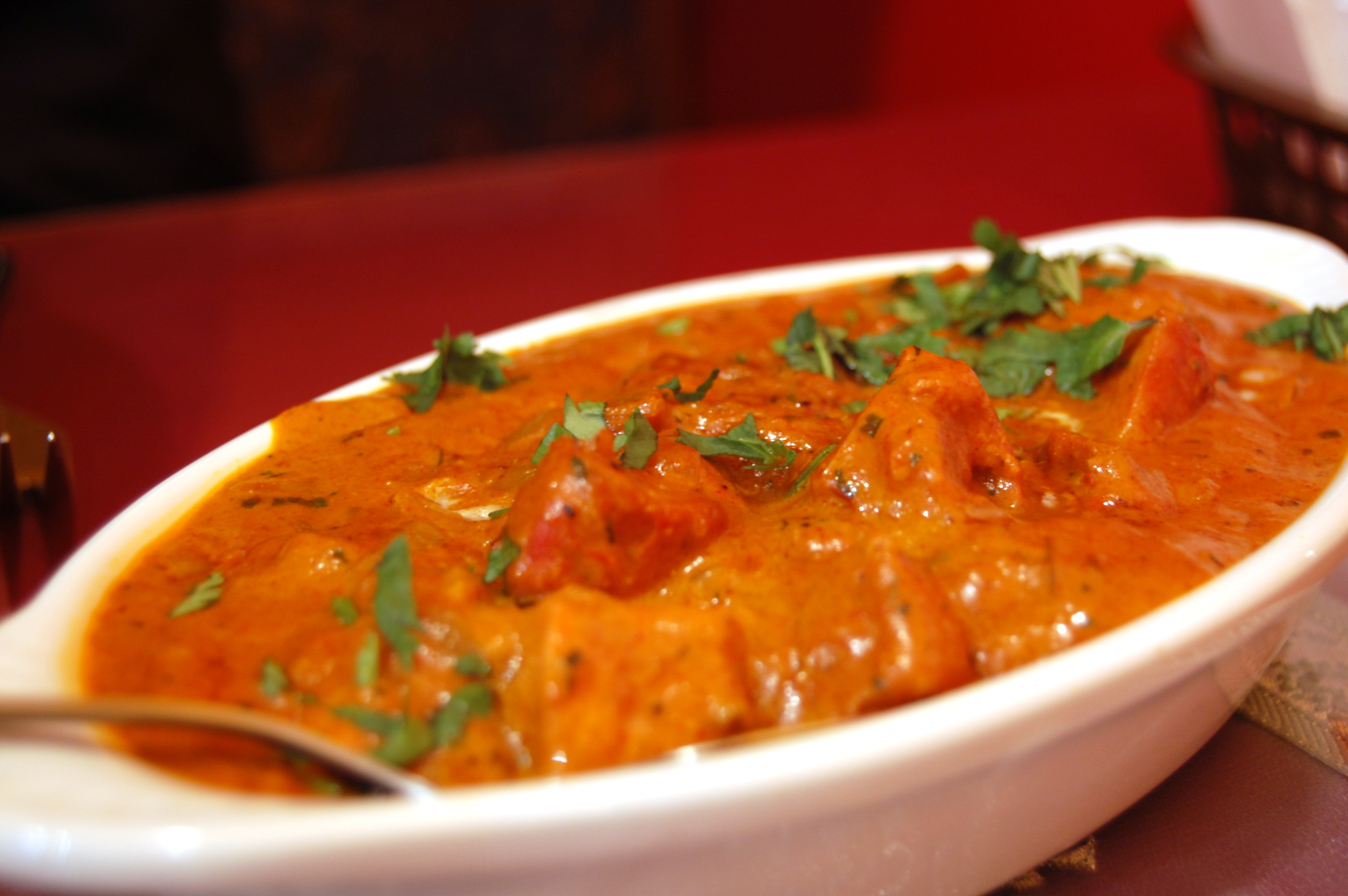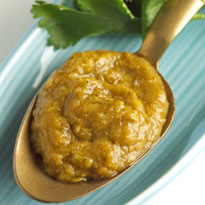Indian Curry Recipe With Curry Paste Biography
Source(google.com.pk)
My Indian friend told me that the Northern Indian curry uses ground nuts to make the curry thick, but there is no shrimp paste, lemongrass or galangal in Indian curry. Those are purely Thai from the beginning. We just added the “spices”, (remember what we consider as spice from my earlier blog) after we adapted the Indian curry to our cuisine.
The origin of Panang is quite funny. I’m referring to an article written by the former Thai Prime Minister Kukrit Pramoj who’s quite knowledgeable in Thai history by his family of origin (Royal descent) and from his vast study of Thai history. He’s not only a great writer but also a great cook. This article was written in Siam Rath newspaper dated September 1st, 1972.
The word “Panang” is derived from the ancient Khmer language that was adopted by the Thai, meaning “cross” mostly referring to leg position, like sitting cross-legged (on the floor). In the old time there was a way of cooking grilled chicken by crossing the chicken’s legs and setting the chicken upright instead of halving the chicken open and cooking it on the grill. The chicken that sat cross-legs up on the grill would be bathed with a curry paste that contained ground roasted peanuts in the paste then mixed with coconut cream. It would be brushed with the same mixture over the whole cooking time on the grill. This is a dish called “Gai Panang” or chicken Panang, due to the position of the chicken on the grill.
Later on, the method had been simplified by cutting the chicken into big pieces and cooking them in the curry in the pot over the stove instead of over the grill. This is the origin of Panang curry.
If you look it up on Wikipedia, the information there about Panang curry is WRONG. Someone has claimed that Panang curry originated from Penang Island in Malaysia, the way it appears on the site right now. I keep correcting it, but the dude who desperately wants the Panang curry to originate from Penang Island is quite relentless. He or she has the same level of desperation as another person who wants PadThai, which had clearly originated in Thailand by a Thai former Prime Minister, to originate from Vietnam!..Stop stealing other nation’s famous dishes, guys. Your countries already have many interesting and delicious dishes as it is.
First of all, to people who think because Panang curry and Penang island have similar pronunciation there should be some relation between the two: this is completely FALLACIOUS THINKING. Panang is pronounced “Pa-Naing”. “Pa” is pronounced with the “ah” like in the word “pathetic”, a very short “a” sound that almost ends before it even fully comes out of your mouth. The “a” in Nang is pronounced like “ai” in the word “air”. That’s the correct pronunciation of the curry by the Thais.
Let’s see how the Thai pronounce the Island’s name, Pe-Nang. “Pe” is pronounced just like “pee”, yes, that yellow pee, long “e” sound. Nang is pronounced more like “ung” than “ang”, like in the word “hung”. So “Pee-Nung” is the pronunciation of Penang island in Malaysia to the Thais, and that is way far from the pronunciation of Pa-Naing the curry.
Often you will see Panang spell, Panaeng, Phanang or even Phanaeng too.
On top of that, someone else is dragging the Peranakan tribe, who live in the south of Thailand , into the mix. Peranakan people associate themselves with the Chinese. Peranakan cooking is derived from Chinese cuisine, mixed with just a hint of Indian spice through the Malaysian or Indonesian influence, but Panang curry is not part of Peranakan cooking. Panang curry also isn’t typical southern Thai food of which the closest area to the Peranakan group, but is more from the central part of the country.
Back to the curry itself. When I was living back at home in Bangkok, I only had Panang curry made with three types of meat: beef, chicken, and the special one that I loved, roasted duck Panang. That’s it. Panang curry paste is the type of curry with spices, coriander seed and cumin seeds. The reason for the spices is to cover up the “meat smell” or game smell of the meat.
Thai people always have a way to cover up the trace of meat; lemongrass, galangal, garlic, and shallots not only enhance the flavors of the dish, but also cover the fishy smell of the seafood, but Thai couldn’t cover the game smell of the meat until the Indians (who really came from India) showed them how.
Authentic Thai Panang Curry 21
The modern day Panang has expanded to many different types of meat, and also includes seafood! Yes, I’m surprised. Personally I think the curry paste itself with spices is a little too much to put on seafood. The spices cover up the seafood flavor. I prefer my seafood with ChooChee curry more than Panang curry.
Back in the day, when I was still a personal chef, cooking for special occasions, my clients often requested Panang curry to be served with either salmon, shrimp, tuna or, quite often, scallops. During the taste test, I would present the requested seafood with both Panang and Choo Chee curries and more than half of them would pick the Panang curry over the Choo Chee curry.
Some of my clients who had quite a fine palette would detect the difference in the curry right away without my explanation, but they still picked Panang over the Choo Chee, which I found out was because they liked the roasted peanuts more than roasted coconut. That made so much sense to me. Some of them even asked if I can remove the spices but keep the roasted peanuts. So I would make the Panang curry paste without spices (no coriander and cumin), but put in roasted peanuts instead of coconut if I want to make seafood Panang.
There are two different ways of cooking Panang curry.
1) Traditional Panang curry with meat or poultry: You will cook the meat WITH the curry. Slow cook, simmer, stew or whatever you prefer to call it. You add water or the water part of the coconut milk to cook with the meat until it’s tender.
2) Modern Panang curry with seafood: You will make the curry paste WITHOUT coriander and cumin, but keep the roasted peanuts. You then cook the seafood the way you want: poached, boiled, fried, sautéed or grilled. Then cook the curry separately and pour it over the seafood, just like the Choo Chee curry.
Also, there is another “Easy Recipe” or cheating recipe, all the way at the bottom, too.
Authentic Thai Panang Curry 1
Ingredients (for 2)
Meat of your choice about 12-16 oz. Sliced or cubed to a bite-size.
Panang curry paste about 1/4 −1/3 cup (see Note #1)
Coconut cream 1-1 1/2 cup (see Note #2)
Water or the water part of the coconut milk 1 cup or more (Note #2)
Salt
Fish sauce (or just salt, if you don’t like it) 2-4 tablespoons (depend on how salty is your curry paste)
Palm sugar (or brown sugar for substitute) 1-2 tablespoons
Chiffonaded Kaffir lime leaves for garnish
Julienned red chili for garnish
Note
1) You can buy Panang curry paste of use the recipe from the Advance Red Curry Paste here. Or you can buy red curry paste and mush the roasted peanuts to the mix.
2) Do not shake the can of coconut milk before you open it. The hard white part at the top is the coconut cream. If the coconut milk you bought has been shaken or isn’t separated, put the whole can of coconut milk in the refrigerator for an hour. You should have the coconut cream floating up on the top and clearer liquid at the bottom. Scoop the cream off to cook the curry paste with and reserve the water.
If you squeeze your own coconut milk then reserve all of the water part.
If the cream doesn’t float, I recommend changing the brand of coconut milk next time. It contains either too much starch or binding agent.
Method
For those of you who want to use SEAFOOD–shrimp, fish, scallop, crab, anything that swim or crawl in water–please refer to the method of cooking Choo Chee curry paste here.
If your choice is meat–beef, chicken, duck, goose, pork, lamb, goat, anything that lives on dry land–follow this method.
1) Cook the coconut cream in the wok or pot over medium-high heat until the coconut cream breaks and gives you coconut oil.
Authentic Thai Panang Curry 2
For those of you who can’t separate the coconut cream out of coconut milk and have to use coconut milk, your coconut milk will not break and give you oil because the manufacturer added starch to stabilize the coconut milk. In that case add coconut oil in your coconut milk. (If you are wondering why we have to do this, go back to my earlier blog. I already explained why.)
2) Add Panaeng curry paste into the coconut cream,
Authentic Thai Panang Curry 3
reduce the heat down to medium and stir continuously for at least two-three minutes until the curry paste releases its aroma.
Authentic Thai Panang Curry 4
If the contents get dry, add more coconut cream or coconut milk.
Authentic Thai Panang Curry 5
I stir-fried mine for 4 minutes. Because of the roasted peanuts in the curry paste, it will burn much easier, so do not stop stirring.
3) Add meat to the wok
Authentic Thai Panang Curry 6
and stir until the curry paste coats all the meat.
Authentic Thai Panang Curry 7
4) Add the water part that you separated from the coconut milk to get the liquid level until it covers the meat and heat until it boils, then turn the heat to low and simmer until the meat is tender.
Authentic Thai Panang Curry 8
If you are using chicken or duck, half an hour to forty five minutes should do it.
If you are using beef or lamb, one to one-and-a-half hours for thinly sliced meat, two hours or longer for cubed, and over three hours for the shank.
If you are using pork, one hour should be enough.
The water will reduce over time, so make sure to add a little bit more. I only add 1/4 cup if it gets too dry. The water doesn’t need to cover the meat at all times. You can stir and churn the pieces of meat around for them to get cooked evenly. Do not add too much water. We want the curry to be thick, not watery.
Authentic Thai Panang Curry 9
5) Once the meat is tender you can season it with fish sauce and palm sugar.Taste it to see if you like the taste, adjust it to your preference. Remember that the curry paste has salty shrimp paste and salt, so do not put ALL of the fish sauce in at once. Add it a little at a time. Do not add sugar in the beginning because it will take longer for the meat to be tender, because sugar will make the meat tougher.
If you don’t like the smell of fish sauce, only use salt.
6) Turn off the heat, plate it and garnish with chiffonaded kaffir lime leaves and julienned red chilis.
Authentic Thai Panang Curry 18
You can eat it with steamed rice, roti, toast, bread or vegetables.
Authentic Thai Panang Curry 25
Or stuff popovers with it!
Authentic Thai Panang Curry 17
Easy or cheating way or making Panang curry
Ingredients:
Meat of your choice, sliced or cubed, or your seafood choice about 12 oz- 1lb.
Pre-made red curry paste, whatever you can find: Kaeng Phed, Kaeng Kua or Kaeng Panang curry paste (I recommend Kaeng Phed or Kaeng Panang curry paste for the meat and Kaeng Kua for the seafood).
Peanut butter 2-3 tablespoons
Coconut milk 1 1/2 – 2 cups
Fish sauce 2-4 tablespoons OR salt (only 1 teaspoon)
Palm Sugar or Brown Sugar 1-2 tablespoons
Coconut Oil 1-2 tablespoons
If you still want to bother with the garnish, please see the choices of garnish from the full recipe above.
Method
1) Add coconut oil to the coconut milk and start cooking the curry paste for at least 2-4 minutes in the pot or wok over medium high heat. Add more coconut milk if it gets dry.
Authentic Thai Panang Curry 11
2) If you are using MEAT or POULTRY, add it
Authentic Thai Panang Curry 13
and stir to coat the meat with cooked curry paste, and heat until the meat is cooked on the outside (seared, essentially, to lock in the juices). Then add more water to the wok until liquid covers the meat,
Authentic Thai Panang Curry 14
heat until the contents boil, then lower the heat to simmer and cook until the meat is tender. (Look for the approximate cooking time and how to add more liquid in the Method#4 above).
If you are using SEAFOOD, cook your seafood separately (fry, boil, grill, microwave, etc…) in another pan or pot.
3) MEAT: Once the meat is tender,
Authentic Thai Panang Curry 15
season with fish sauce or salt, and sugar. Adjust the taste to your preference, then add the peanut butter. In this step you would lose the oil that floats on top of the curry, but it still tastes great.
Authentic Thai Panang Curry 16
SEAFOOD: In the curry pot, add more coconut milk and start seasoning the curry with fish sauce (or salt) and sugar, then add the peanut butter. Adjust the taste to your preference. Pour the sauce over cooked seafood.
Indian Curry Recipe With Curry Paste

Indian Curry Recipe With Curry Paste

Indian Curry Recipe With Curry Paste

Indian Curry Recipe With Curry Paste

Indian Curry Recipe With Curry Paste

Indian Curry Recipe With Curry Paste

Indian Curry Recipe With Curry Paste

Indian Curry Recipe With Curry Paste

Indian Curry Recipe With Curry Paste

Indian Curry Recipe With Curry Paste
Indian Curry Recipe With Curry Paste

Indian Curry Recipe With Curry Paste

Indian Curry Recipe With Curry Paste

Indian Curry Recipe With Curry Paste

No comments:
Post a Comment